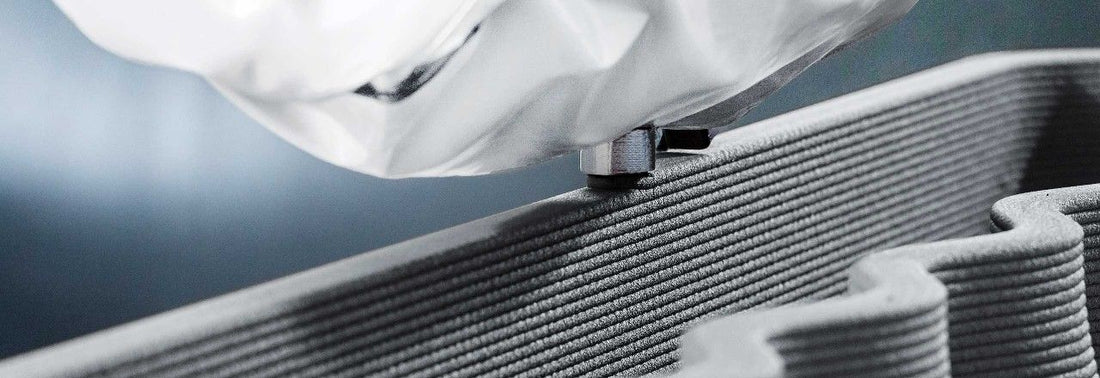How Can the Construction Industry Make Use of Additive Manufacturing?

The construction industry is typically conservative, slow to adopt new technology, and lags behind other sectors in terms of productivity gains. However, it is constantly growing – and these challenges must be overcome.
Industry disruptors are already beginning to make use of digital and automated technologies to address some of those latent issues in construction. Building information modelling (BIM) is being adopted both by large construction firms and boutique companies to improve the quality and efficiency of numerous projects. Computer assisted design (CAD) has become an integral part of almost all building projects.
Further, additive manufacturing (AM) techniques including 3D printing and scanning are increasingly being used in the construction industry. This white paper discusses some of the ways construction is already making use of AM, and highlights gaps where the industry could use it more for various benefits.
AM in pre- and post-construction phases
Although not as widespread as other industries – for example manufacturing – AM is being used in construction today. However, this is largely limited to the pre- and post-construction phases of building projects.
In design, 3D-printed architectural models have been an integral part of architects’ and developers’ toolboxes for decades. These are far less labour-intensive to produce than traditional models and can be generated digitally using CAD.
Benefits include ease of communication between architects, developers and other stakeholders, even at a geographical distance. This can help to reduce redundancies between architects and external specialists such as engineers and planning managers.
In the post-construction phase, AM is often used to create bespoke decorative finishes, while 3D scanning can be used to retroactively create BIM data to enable more automation in maintenance programmes, or to support remodelling projects.
Benefits of AM in construction phase
Despite its relatively widespread adoption amongst designers, planners, architects and building managers, AM is yet to realise its full potential in the main construction phase of building projects.
This potential is well-documented in the academic literature, and much effort is being made by researchers to enable the industry to make use of the advantages AM promises. This is focussed on printing materials directly into structures, as is the case with 3D-printed concrete (3DPC).
3DPC, due to its potential for high compression strength, low cost and wide scope for design freedom, has already been used in research and concept projects. The first fully 3D-printed building was completed in Nantes, France in 2017. The project – jointly undertaken by Nantes University and Bouygues Construction – took only three days to complete, required less concrete and other materials, and emitted 75% less CO2 than traditionally constructed counterparts.
As well as concrete, metals and polymers are also being explored to 3D print structural elements of buildings. In the case of metals, AM can be used to create bespoke connecting joints for curtain walling and facade engineering. The benefits of AM in this application include a far greater degree of design freedom for architects, who no longer have to rely on standardised structural parts when mass-production of custom shapes is possible.
As well as increasing industry adoption, further research is needed for construction to realise the full benefits of AM. Insufficient standardisation and testing need to be tackled to allow architects and engineers to design and assess buildings safely. Workflow processes need to be firmly established to enable for greater adoption of AM in construction. Materials and methods still need to be developed to make AM a viable alternative to traditional methods.
Despite these challenges, the benefits of widespread adoption of AM in the main construction phase of building projects are already becoming clear to see. It can save time and reduce local disturbances by allowing buildings to be completed around the clock, and can significantly save on logistics costs (both economic and environmental) by creating products on-site.
As discussed, AM also enables far greater levels of design freedom, can help to optimise materials and energy consumed in construction (as seen in the Nantes building), and can significantly reduce labour costs by automating parts of or – eventually – entire projects.
AM in specialist construction applications
Due to its potential for automation and the removal of human labour from the equation, AM could be deployed in a number of specialist applications to great benefit. These include hazardous sites where the risk to human life is too high for a traditional construction project to go ahead.
For example, in disaster relief contexts, AM can be used to build shelters and emergency hospitals quickly and efficiently – when human and material resources are in short supply.
In hazardous environments such as mines, underwater and even outer space, AM will be used to create useful structures that would otherwise be impossible for human labour to build. In extremely remote locations, construction and maintenance can be automated with AM to eliminate the potentially vast costs of transporting and accommodating a human workforce.
AM in peripheral construction applications
Increasingly, AM can be used to create custom parts and components. For the construction industry, this could mean on-site customisation and fabrication of specialist tools and equipment – representing a significant cost saving to developers.
With 3D scanning, it is also possible to reverse engineer ruggedised parts that were designed before the advent of CAD technology, in order to perform value engineering and optimisation of the part or tool. As well as tools and equipment, building parts and entire buildings can be 3D-scanned to support the creation of CAD and BIM data for further optimisation and management.
As discussed above, the easy integration of AM with other digital technologies such as CAD and BIM supports its adoption in many diverse applications in the construction industry. In this way, AM is part of a wider kit of tools becoming available to forward-thinking players in the construction industry.
Conclusion
This paper has discussed the ways in which AM is already being used in the construction industry, areas for improvement in terms of adoption, and the benefits and potential of AM to significantly disrupt the industry.
AM is in a boom phase in many industries, and has been widely adopted to great benefit in applications as diverse as manufacturing and medicine. Its potential is yet to be fully realised in construction, but the opportunity is there for the taking.
If you want to discuss how AM can benefit your construction project or enterprise, contact Evo3D now.
Sources and further reading
Delgado Camacho, et al. (2018). “Applications of Additive Manufacturing in the Construction Industry – A Forward-Looking Review.” Automation in Construction. Online.
Ghaffar, Seyed Hamidreza, Jorge Corker, and Mizi Fan (2018). “Additive Manufacturing Technology and Its Implementation in Construction as an Eco-Innovative Solution.” Automation in Construction. Online.
Evo3D (2020). “The Benefits of Reverse Engineering with 3D Scans.” Evo3D.
Keating, Steven J., et al. (2017). “Toward Site-Specific and Self-Sufficient Robotic Fabrication on Architectural Scales.” Science Robotics. Online.
Labonnote, Nathalie, et al. (2016). “Additive Construction: State-of-the-Art, Challenges and Opportunities.” Automation in Construction. Online.
Paolini, Alexander, Stefan Kollmannsberger, and Ernst Rank (2019). “Additive Manufacturing in Construction: A Review on Processes, Applications, and Digital Planning Methods.” Additive Manufacturing. Online.
